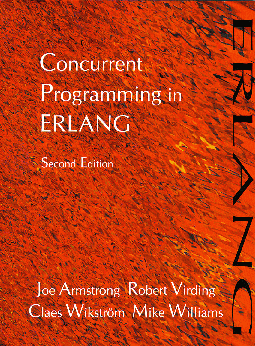Concurrent Programming in Erlang

J. Armstrong, R. Virding, C. Wikström, M. Williams
2:nd Edition
Prentice Hall, 1996, ISBN 0-13-508301-X

Distributed Erlang programs can run transparently on cross-platform multi-vendor systems. The language has primitives for detecting run-time errors and for dynamic code replacement (i.e. changes to code can be made in a running real-time system, without stopping system).
Erlang has real-time GC, modules and a foreign language interface.
Erlang was developed at the Ellemtel Telecommunication Systems Laboratories and is used within Ericsson for product development and prototyping.
Part I. Programming. Chapter 1 An Erlang Tutorial 1.1 Sequential Programming 1.2 Data Types 1.3 Pattern Matching 1.4 Built-In Functions 1.5 Concurrency Chapter 2 Sequential Programming 2.1 Terms 2.2 Pattern Matching 2.3 Expression Evaluation 2.4 The Module System 2.5 Function Definition 2.6 Primitives 2.7 Arithmetic Expressions 2.8 Scope of Variables Chapter 3 Programming with Lists 3.1 List Processing BIFs 3.2 Some Common List Processing Functions 3.3 Examples 3.4 Common Patterns of Recursion on Lists 3.5 Functional Arguments Chapter 4 Programming with Tuples 4.1 Tuple Processing BIFs 4.2 Multiple Return Values 4.3 Encrypting PIN Codes 4.4 Dictionaries 4.5 Unbalanced Binary Trees 4.6 Balanced Binary Trees Chapter 5 Concurrent Programming 5.1 Process Creation 5.2 Inter-Process Communication 5.3 Timeouts 5.4 Registered Processes 5.5 Client--Server Model 5.6 Process Scheduling, Real Time and Priorities 5.7 Process GroupsBasic concurrent programming techniques. Creating and monitoring processes. Sending messages between process. Monitoring processes. The client-server model is introduced. Primitives for real-time programming.
Chapter 6 Distributed Programming 6.1 Motivation 6.2 Distributed mechanisms 6.3 Registered Processes 6.4 Connections 6.5 A Banking ExampleThe language primitives have the same properties in a distributed system as in a single node system.
Chapter 7 Error Handling 7.1 Catch and Throw 7.2 Process Termination 7.3 Linked Processes 7.4 Run-Time Failure 7.5 Changing the Default Signal Reception Action 7.6 Undefined Functions and Unregistered Names 7.7 Catch versus Trapping ExitsBasic error handling mechanisms. Catch and throw. Detecting process termination.
Chapter 8 Programming Robust Applications 8.1 Guarding against Bad Data 8.2 Robust Server Processes 8.3 Isolating Computations 8.4 Keeping Processes Alive 8.5 DiscussionBasic programming techniques for programming fault-tolerant applications.
Chapter 9 Miscellaneous Items 9.1 Last Call Optimisation 9.2 References 9.3 Code Replacement 9.4 Ports 9.5 Binaries 9.6 Process Dictionary 9.7 The Net Kernel 9.8 Hashing 9.8 EfficiencyChanging code in a running system without stopping the system. Interfacing to foreign languages.
Part II. Applications
The applications part of the book is a set of case studies. Here we build on the programming techniques of Part I to construct complete programs. Many of the studies are based on real-world applications.
Chapter 9 Databases 9.1 The Access Functions 9.2 Simple Database 9.3 A Multi-Level Database 9.4 Transaction Management 9.5 External DatabasesSimple database programs, with transactions, roll-back, fault-tolerance, etc..
Chapter 10 Distributed Programming Techniques 10.1 Remote Procedure Calls (RPC) 10.2 Multicalls 10.3 Broadcasting 10.4 Global Registration 10.5 Promises 10.6 Mulitcasting to Process Groups 10.7 Negotiation Techniques 10.8 Adaptive Load Distribution 10.9 Relay Techniques 10.10 Parallel Evaluation for Speed 10.11 DiscussionRPC, the ability to evaluate a function transparently an a remote node.
Erlang provides simpler primitives for RPC, global name servers, error detection etc. than many operating systems.
Chapter 11 Distributed Data 11.1 Shared Data 11.2 Partial Replication 11.3 TransactionsMany applications may wish to have some common data structures available for access and modification by several processes on several nodes. This chapter describes various techniques for sharing data between physically separated nodes.
Chapter 12 Operating Systems 12.1 Overview of the Standard Erlang OS 12.2 System Startup 12.3 Code Management 12.4 The Input/Output System 12.5 The Standard ShellAn overview of the standard Erlang operating system.
Chapter 13 Real-Time Control 13.1 A Lift Control System 13.2 A Satellite Control SystemTwo real-time (process control) applications.
Chapter 14 Telephony 14.1 Typical Aspects of Switching System Software 14.2 POTS 14.3 Robustness 14.4 SDLA telephony application. This is sub-set of a much larger program which used to control an Ericsson PABX in a real-world application.
Chapter 15 An ASN.1 Compiler 15.1 Background 15.2 About ASN.1 15.3 BER -- Basic Encoding Rules 15.4 Implementation 15.5 ASN.1 ApplicationsA cross compiler from ASN.1 (The CCITT specified data transport definition language) to Erlang. This again is from a real-world application.
Chapter 16 Graphics 16.1 The User Interface 16.2 Basic Graphics Primitives 16.3 A Pocket Calculator 16.4 A Prompter 16.5 A TV SimulationBuilding a graphic user interface in Erlang. This shows how Erlang can be interfaced to the X-windows system to build an advanced GUI.
Chapter 17 Object-Oriented Programming 17.1 Basic Concepts 17.2 Mapping to Erlang 17.3 An Object-Oriented Interface 17.4 Object-Oriented Programming 17.5 Object-Oriented DesignDiscusses the relation between Erlang and Object-Orientated programming.